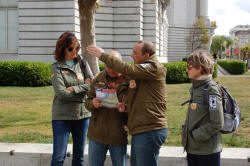Asking about, asking to, asking for and inviting: requestives

There is, of course, a difference between the functions that the
following uses of the verb ask are realising.
Clicking on the
![]() will reveal what the differences are if you don't immediately get
them.
will reveal what the differences are if you don't immediately get
them.
| Language | Function | |
| 1 |
She asked me when the train left |
elicit
information
|
| 2 |
She asked me to help her |
request action
|
| 3 |
She asked me for the money |
require
|
| 4 |
She asked me to dinner |
invite
|
And that means we are already alerted to a potential problem.
There is, as you are aware, no doubt, no one-to-one relationship
between form and function in any language so we have to be careful
to approach a loosely defined function such as asking by
being a bit more precise about what we mean.
In many other languages, the translation of the word ask in
these sentences will be different in every instance. In some,
only the first two will differ from the last two, in others, the
last will differ from the first three, in a few, the second will
differ from all the others, in some the verb will be different in
all four cases and in some other languages, the same verb will
suffice, as it does in English, for all four functions.
French will use the same verb in all instances, German will use the
same verb for examples 2, 3 and 4 but a different one for example 1,
Russian, Spanish and most Chinese languages will use the same verb
for examples 2 and 3 but a different one for example 1 and a
different one again for example 4 and so on.
If nothing else had altered us to the issue, that should because if
any language sees fit to have a different verb for ask in
any of the examples, then it is clear that people
see some at least as functionally different.
We will look at all four of these functions, consider them in the context of the grammatical structures we may use to realise them and then look at how they fit in with other functions and what the adjacency pairings might reveal.
In this guide, we will not focus too much on the really
straightforward ways of making requests such as:
I would like that, please
because such a realisation of a request, although it is heard, is
actually quite rare. Teaching in this area is often,
unaccountably, confined to unnatural expressions like this.
(In what follows, there is no attempt to provide an exhaustive
list of possible exponents because we are not taking a phrase-book
approach but endeavouring to analyse the functions and their
realisations in general terms.
We will also focus for the most part on spoken language but the
function and the example exponents can just as well be expressed in
writing including, naturally, any appropriate response routines.)
 |
Speech acts: pre-heads, heads and post-heads |
But first, we need to get an important functional concept clear.
Often, when the concern is the realisation of a function, the focus
is, as it should be, on the head or central speech act which the
function signals. However, if it remains only there, the
result can be slightly abrupt and unnatural language.
For example, the function of introducing oneself is realised by
something like:
My name is John Smith
but, standing alone, that is an unlikely thing to say and would more
likely be realised as something like:
Hello. My name's John. How do you
do?
or whatever.
You may be familiar with the concept of heads and pre-heads etc. in
the analysis of phrases so, for example:
The old man in the corner
is a noun phrase with man as the head (because that is the
defining characteristic of a noun phrase) and a pre-head modifier (the
old) along with a post-head modifier (in the corner).
We can apply the same kind of consideration to speech acts so,
for example, starting with:
help me
which is the head speech act containing the request, we can have a
pre-head to show some deference such as
Can you ...
and a post-head giving some detail of what's being asked for such as
with this table
and that provides the entire utterance as:
Can you help me with this table?
It is, naturally, not necessary to burden learners with the
meta-language of the analysis but teaching only the imperative head
forms:
Give me
Help me
Show me
etc.
is clearly inadequate and will result in overly direct imperatives.
Softening the language with a politeness phrase such as:
Could you ...
I wonder if I can ask you to ...
It would be nice if you could ...
etc.
will provide the necessary level of deference but that alone will
not result in much response unless there is a post-head phrase
giving some detail of what's required such as
... a hand
... with this case
... how to do it
etc.
This three-part structure is, arguably, not a target for direct
teaching because most languages work in the same way (although in
many the bare imperative is not impertinent or too direct) but it is
noticeable that unless learners have at least been alerted
to the functions of the language, they are often tempted to omit the
pre- or post-heads or both.
A simple boarded chart such as:
| Pre-head: politeness signal | Head: request | Post-head: detail |
| Could you | give me | a hand with this table? |
| I wonder if you can | help me | with this program |
| It would be nice if you could | show me | how to enter the data |
helps the noticing along and thereafter, once that is clear, you can
get the learners to break down the language of similar functions
such as:
Can you tell me the way to the station?
Would you please call me if a room becomes vacant?
I wonder if you can come with me to help with the furniture
into the three constituents and that reinforces the point.
This also gives you, the teacher, the opportunity quickly and
accurately to correct and enhance the learners' output so that they
can form appropriate requestives.
The same kind of analysis for teaching purposes can, of course,
be applied to a host of other functions realised in language such as:
Oh dear, I really am sorry if I disturbed you this morning
That looks heavy – can I help you get it in the
house?
etc. which might look like this although the content and nature of
the pre- and post-head acts will alter depending on the
circumstances and the intentions of the speaker.
| Pre-head dismay | Apology | More information |
| Oh dear | I really am sorry | if I disturbed you this morning |
| Pre-head introduction | Offer | More information |
| That looks heavy | can I help | you get it into the house |
Now we've got that clear, we can return to our analysis of asking functions.
 |
Factual elicitation |
This is the simplest place to start because eliciting information is the primary use of the verb ask from which all other meanings derive.
The structural realisations of this function are accordingly
rather simple although politeness routines in English are sometimes
neglected. It is vanishingly rare, for example, to approach a
complete stranger and say:
Where is the post office?
although such a formulation between friends, acquaintances, family
members and colleagues is common and inoffensive.
Other cultures are more direct and in many the bald question does
not carry the sense of abruptness or discourtesy which it does in
English.
English users will normally opt for an indirect question form in all
circumstances involving strangers and will often do so even when
there is no social imperative to be distant and polite.
Common realisations include:
- Do you (happen to) know ... ?
- Could you tell me ... ?
- Can you tell me ... ?
- Can I ask you ... ?
and there are more which a few minutes' thought can identify.
The key teaching point with this function is the nature of the
indirect question form in English because all the above may be
followed by no inversion of subject and verb or use of the do-operator so would finish as:
... what time the bus leaves?
... where the station is?
rather than the more logical:
... *what time does the bus leave?
... *where is the station?
Even at quite high levels of mastery, many learners will produce the
superficially logical rather than grammatically accurate form.
See the guide to indirect questions, linked below for more.
A separate, and separably teachable, form of information
elicitation concerns the use of if and whether as
they apply to alternative events. For example:
Could you tell me whether this train stops at
Margate?
Do you happen to know if this is the right place to get a
ticket?
I wonder if you know whether this is the right road to
Portsmouth
and so on.
The distinction here, naturally, is that the question is aimed at a
yes-no response rather than an open-ended piece of information.
Hence the use of the if / whether formulations.
For more on that, see the guide to indirect questions, linked below.
 |
Responding to factual elicitation |
Responses are, likewise, reasonably simple and there are only three functions forming the corresponding half of the adjacency pair:
- Preferred positive response:
- Yes, at ten past six
- Yes, it's just around the next corner
- Yes, it does
etc.
- Dispreferred negative response:
- Sorry, no.
- Can't help, I'm afraid
- No, you need the next train
etc.
- Dispreferred but rarer temporising response:
- It might be about seven but I'm not sure
- I think it's in that direction but you'd better ask again
- I'm not sure. Why not
ask at the information desk?
etc.
The second two of these possibilities is an area often neglected in classrooms and, alas, course materials but the ability to use dispreferred responses is an important communicative skill.
 |
Hortation |
The second function identified at the outset was that of asking for action but there are two significantly different ways to do this:
- Cohortation
which concerns getting people to cooperate with us in doing something. - Exhortation
which concerns encouraging someone else to do something.
 |
Cohortation |
Cohortative requests are nearly always in the first person plural by their nature because they are aimed at evincing joint actions of the speaker and hearer.
In English, the most common way is the let’s construction which contains the only example of the
abbreviated us in English. To use the full form,
let us, is considered formal and mostly reserved for
written language or prepared statements and speeches.
The contracted let’s construction is always
cohortative. If you say it in full, it usually becomes an
imperative.
Compare:
Let us go
usually meaning Release us!
It is possible to
use this full form as a cohortative but it sounds odd and may be
ambiguous.
In writing, it is more common, especially as a form of
conjunct in, e.g.
Let us now go on to consider ...
etc. with:
Let’s go
meaning I am encouraging
you to cooperate in leaving now
An alternative, in British English, is the use of the modal
auxiliary verb shall which has died out in its use as a
future marker but retained for its cohortative use as in, e.g.:
Shall we get this finished before we take a
break?
A third way is via the use of a quasi-suggestion along
the lines of
How about ... + -ing?
Would(n't) it be better if we ... ?
Shouldn't we ... ?
etc.
We called these quasi suggestions because they are not intended to
put forward an idea but to elicit cooperative action from the
hearer(s).
When the function is really to make a suggestion, the choice usually
falls on third-person forms.
Again, for teaching purposes, simply taking a phrase-book
approach to the area is inadequate because cohortation requires
pre-head language to signal some deference or understanding of
troublesomeness and a post-head expression which often signals a
reason for the hortation.
We get, therefore, for example, as pre-heads:
I'm getting tired so ... (expressing
personal weakness and relieving the other of responsibility)
It's getting late so ... (expressing a
reason for a subsequent request for cooperation)
It's a lovely evening so ... (expressing
an environmental cause exterior to both parties)
and post-heads such as
... when we are fresher (expressing a
consequence of an action)
... and finishing in the morning
(expressing a positive consequence)
... and see if Mary and John are there
(expressing a positive possibility following the action)
Putting all those together, we get the more natural and less direct
utterances such as:
I'm getting tired so how about taking a break
and coming back to it when we are fresher?
It's getting late so how about stopping now and finishing in
the morning?
It's a lovely evening so let's go down to the pub and have a
drink in the garden and see if Mary and John are there
Referring to the tabular three-part structure of such realisations which was provided above can help learners sound considerably more natural although the language is simple enough. It would appear something like this:
| Pre-head: reason for request | Head: request | Post-head: desirable consequence |
| I'm getting tired so | how about taking a break | and coming back to it when we are fresher? |
| It's getting late so | how about stopping now | and finishing in the morning? |
| It's a lovely evening so | let's go down to the pub | and have a drink in the garden and see if Mary and John are there |
 |
Exhortation |
Exhortation can be achieved (as above) with a simple imperative
in English, such as:
Help me with this
Tell me the way
Show her how to do it
Explain the way to do this
etc. but the use of the imperative mood is actually quite rare and
usually confined to two ends of the social spectrum: those in
authority to people with less power and people in close
relationships who are unlikely to be offended and have equal
authority.
Even in customer-server relationships in English, imperatives are
routinely softened with at least a please and thank you
but that is not universal across cultures.
In most other cases, the imperative needs to be carefully softened
if it is not to offend.
There are many ways to do this, but this is not a phrase book, so a
few examples will suffice:
Please can you ...
Could you ...
Can I ask you to ...
I wonder if you have time to ...
etc.
(Hunt the web for sites run by those who like to collect phrases for
more.)
All the softeners exemplified here are pre-heads of course but
exhortative expressions also frequently contain post-heads
expressing a reason for the request to soften it further and show
that the asker understands that the request might prove troublesome.
They might include:
... because I'm not sure I can manage alone
... because I'm a bit lost
... because you are the expert
... although I know you are busy
and so on.
Thus, we arrive at the whole exhortative requestives of:
Please can you help me with this because I'm
not sure I can manage alone
Could you tell me the way because I'm a bit lost
Can I ask you to show her how to do it because you are the
expert
I wonder if you have time to explain the way to do this
although I know you are busy
which are all far more likely to result in a positive,
preferred response than bare imperatives will.
Again, a little three-part analysis will often help things along:
| Pre-head: politeness signal | Head: request | Post-head: reason |
| Please can you | help me with this | because I'm not sure I can manage alone |
| Could you | tell me the way | because I'm a bit lost |
| Can I ask you to | show her how to do it | because you are the expert |
 |
Responding to hortation |
|
Let's go home OK |
Responses to hortative expressions are less straightforward and determined often by whether the meaning is cohortation or exhortation.
- Cohortation
- Preferred positive response:
- Yes, fine. Good idea
- OK
- Yes, let's
etc.
- Dispreferred negative response (counter proposal):
- No, let's get on
- I'll be too busy then so shall we just ...
- No, I think we should ...
etc.
- Dispreferred but rarer temporising response:
- Just a few more minutes
- In a little while
- I understand but ...
etc.
- Preferred positive response:
- Exhortation
- Preferred positive response:
- Yes, I can do that
- Sure
- I'll get it done
etc.
- Dispreferred negative response (often with a reason):
- No, I can't right now
- I've got too much else to do, I'm afraid
- Sorry no
etc.
- Dispreferred but rarer temporising response:
- Can it wait a bit?
- In a little while
- Try asking John
etc.
- Preferred positive response:
Again, the ability to recognise which kind of response is appropriate for which kind of hortation is important as is, again, the ability to deploy dispreferred responses.
 |
Requiring things |
You do not have to be too perceptive to note that the elicitation
of information often involves nominalised clauses of one kind or
another. For example:
Do you know when the train leaves?
contains the clause when the train leaves functioning
as the object of the verb know so the clause itself is made
into a noun in terms of its grammatical, rather than communicative,
function. The structure of the sentence is akin to:
Do you know the time?
Do you know the way to London?
Do you know her brother?
etc. in which the objects are more familiarly simple noun
phrases.
Requiring things is actually simpler than enquiring about
information because the object of the request usually is
a noun phrase rather than a nominalised clause or phrase. We
could say, for example:
Give me the papers
Pass me that hammer
Transfer the money to me
and so on in which the clause structure is extremely simple.
Most learners even at quite low levels can deal with a simple Verb +
Object structure of that sort, albeit with the added complication of
the indirect objects (me in all cases).
However, a moment's thought reveals that most requests for
things are not couched in such direct terms and that, even between
participants with very different amounts of authority, bald
imperatives of this sort are rare and when used, often offensive.
Getting things, therefore, rather than information or cooperation
often requires even more attention to pre-head politeness stratagems
and post-head justifications for the demand.
Here are some examples:
- Please let me have your answer so I can get on and book the tickets
- Can you pass me the salt?
- Would it be possible for you to let us have the money tomorrow so we can deliver the stuff promptly?
- If you can let us have an address for this we'll get the materials to you
and so on.
There are, of course, some things to note:
- The expression frame:
Please / Can you + let + indirect object + have + direct object
is a widely used, polite and simple way of requiring things that is seldom taught but extremely versatile. It is difficult to think of an object noun with which its use would not be appropriate and inoffensive. It can be used freely with physical entities such as:
some more butter
two coffees
two glasses
and with abstract concepts such as:
your decision
a little more time
your help and support
etc. - Even between people who are close and in an informal setting, the bare imperative is often softened by an introductory Please although a post-head justification is rarely needed.
- Conditional structures are extremely useful because they do
two things:
- they add a sense that the hearer may reject the request without offence because they sound tentative and modest
- they explicitly connect the request to the reason for it so providing a neat way to state the justification normally put in the post-head with so, because, in order to etc.
- All the verbs so far used in our examples are ditransitive
because we wish not only to refer to the direct object but also
to state openly who is the indirect object of the request.
Not all ditransitive verbs are likely to appear in requests for
things but a surprising number are and they form a teachable
unit. Here's a list:
and every one of these verbs can be fitted into a structure which includes a softening pre-head (please, can you, could you etc.) + the request (verb + indirect object + direct object) and a post-head justification if one is needed.bring
buy
call
draw
emailget
give
hand
lend
loanorder
pass
post
pour
promiseprovide
read
reserve
sell
sendshow
spare
tell
text
throw
Please can you buy me some apples if you pass the fruiterer?
Please draw me a map so I don't get lost
Can you give me a few minutes? I need to think
Please post me the results
Could you spare Peter a little time later?
Please send my son the address because he needs to know where to go
and, of course, the structure with let ... have fits into the same sentence frame.
It is possible, with this simple structure, to generate hundreds of perfectly grammatically correct and perfectly appropriate requests for things and abstract entities and that can be done at almost any level.
Once the structure is even partially automated, few errors will be made and the focus can shift to the post-head justification and other issues of, e.g., intonation and tone.
It is also the case that the simple elicitation of information pattern which we saw above such as:
Could you tell me when the train leaves?
also falls into this patterns although the direct object is normally a nominalised clause so it should be reasonably familiar.
Some verbs, particularly, give, show, send and tell, almost require the statement of the indirect object unless it has been made clear from the context and co-text.
 |
Responding to requests for things |
|
Pass me a peanut Here you are |
By the nature of the function, responses are straightforward to learn and teach because they are usually going to fall into the first, preferred and positive category (which should not mean that the other two are neglected) as the request would rarely be made unless the maker is reasonably secure in expecting a positive outcome.
- Preferred positive response:
- Sure, here you are
- Yes, of course, I will
- Coming right up
etc.
- Dispreferred negative response:
- I can't do that, I'm afraid
- Can't help, I'm afraid
- No, that won't be possible
etc.
- Dispreferred but rarer temporising response:
- It might be possible but you'll need to ask ...
- I think it's going to be difficult but I'll try
- Only if the time is available
etc.
 |
Invitations |
| Come in! |
This is where our carefully set out three-part structure with a
politeness signal, a head and a post-head justification or reason
falls apart.
In fact, invitation are almost the reverse of requests because the
inviter holds all the cards and does not need to trouble to save the
face of the invitee or to be terribly polite and deferential.
The inviter has little to lose.
Of course, if this function is lumped in with the other forms of
requests we have outlined here, because there are obvious structural
parallels, then the speaker can sound too polite and deferential and
that will result in some confusion at least, suspicion at worse.
Even here, however, most Anglophone cultures still persist in a
softening pre-head although it is often confined to an unelaborated
please rather than the convoluted expressions with
I
wonder if ..., could you see your way clear to ... etc. which are often the pre-heads
of requests. We do not often find, therefore:
Come with us to the park
Take some more
Stay a while
etc. because even in this circumstance, bald imperative statements
are often felt to be too direct so we often prefer:
Would you like to come for dinner?
Please help yourself to more
Can you manage to stay a bit longer?
etc.
 |
Dressing up invitations |
The issue with invitations is that the inviter is opening up to
the possibility of losing face should the invitation be rejected.
For this reason, among others, the invitation is often couched in
terms which imply a different form of request altogether, so, for
example, we may find:
I wonder if you have time to come for a drink
this evening? (dressing an invitation as an elicitation of
information)
Can you spare the time to visit?
(dressing an invitation as a request for action)
Let's take you to the pub this evening
(dressing an invitation as a cohortation)
and, of course, the form of an invitation often parallels that of an
exhortation as in:
Please stay for a bit
etc.
Teaching the language of invitation is also straightforward because
it is unlikely that any invitation, even one badly phrased will
cause any offence or be rejected because of its form. Any of
the kinds of expressions we have exemplified above will work
reasonably well.
 |
Responding to invitations |
Responding to invitations is straightforward when the response falls into the first, positive and preferred category. At other times, it is exceedingly difficult to strike the right note and learners of English may inadvertently cause offence.
Preferred responses are straightforward and can be taught as pre-fabricated chunks such as:
- I'd love to
- Yes, please. What time should I come?
- That sounds lovely
- Yes, of course. That's very kind of you
However, care should be taken to make learners aware that invitations differ from other forms of requests and that, therefore, other positive responses appropriate elsewhere do sound odd or even offensive so they should be careful to avoid, e.g.:
- Yes of course
- Yes, I will
- Of course, I will
all of which are responses to other sorts of requests.
It is with dispreferred responses that the greatest care needs to be taken because rejecting an invitation is, in many cultures, including Anglophone ones, a serious face-threatening act.
Outright rejection is quite rare and always, always
includes a reason for the rejection, however flimsy the excuse may
be. It is extremely rare to find, for example:
I'm sorry I can't come
and almost impossible to encounter
No, thanks, I don't want to come
better formulations include:
- I'd love to but I'm afraid I have to stay home because I'm expecting a call from my sister
- Oh what a shame! I'm sorry. I'd love to but I have to work late on Thursday
- Well, it's a lovely idea but I'm afraid I'm a bit old for horse-riding!
such formulations will almost always include:
- an expression of dismay such as What a shame, What a pity, Oh dear etc.
- an apology such as I'm afraid, I'm really sorry but .. etc.
- a reason for the rejection such as the ones above.
Points 1 and 2 can be taught as pre-fabricated language chunks but point 3 requires a little imagination.
Temporising responses are probably as common if not more common than outright rejections and they need some attention because getting the tone and language right is challenging even for native speakers. They might include:
- Thursday's really difficult. Can we make it another time?
- I'm not sure what my schedule is. Can I let you know later in the week?
- I'll have to check my timetable for the month. I'll call you back
and so on.
A key advantage of many temporising statements is that they prepare
the ground for a later rejection because the invitee has signalled
that there may be a problem and the inviter is prepared and
reconciled to that. Indeed, skilful speakers will often use a
temporising response in the knowledge that there will be a need for
a later outright rejection as a way of softening the latter.
 |
Teaching the area |
This has been a brief guide focusing only on four types of requests but it is clear (or should be by now) that the different forms that requests take: asking about, asking for, asking to and inviting, require different structural and lexical realisations.
- The first moral, therefore, is to focus on each type in turn and be thorough in teaching that before moving on. Jumbling the types up will result in confusion and inappropriate language and runs the risk of unnecessary offence being given.
- A phrase-book approach is rarely helpful but breaking the area down into pre-head, head and post-phases is often helpful.
- The next moral is to focus on both sides of the adjacency pairings. There is little point in knowing, for example, how to ask whether someone knows something unless one can also understand what the response signifies.
- Being able to respond to a requestive is also a key communicative skill in its own right but one needs to know how to form and deliver dispreferred as well as preferred responses.
- Response types vary with request types, as we have seen, and what is appropriate in one case is unlikely to be in another so, while the acquisition of some language chunks is a very useful thing to focus on, learners also need to be aware of the types of requestives in which the chunks should be contained and the response types in which they can be deployed.
| Related guides | |
| indirect questions | for the guide to the way in which requests are often encoded |
| suasion | this is an overall view of the area in question which considers a good deal more than requestives |
| responding to suasion | for more positive, negative and temporising responses to suasion |
| functions | for the index of more guides in the general area |
| spoken discourse | for a general guide to making meaning in speech |
| communicative strategies | a guide to teaching the strategies and tactics required in accurate communication |
